Kitcho (吉兆) Taipei
Sharing photos and notes from our 4000NTD omakase dinner in March 2018
Hey! My sister Rose and I ate there a couple days ago and I thought it'd be fun to share my notes and photos from the meal.
Our reservation was for 7:00 pm. Since Taiwanese eat dinner relatively early, we were the second-to-last party to sit down, and the last to leave. Inside, the space was small but not cramped. There were approximately 12 seats at the counter (two on the wraparound on each end), one bathroom down the hall, and one small open room in the back with two tables. There were two chefs behind the counter, and one helper chef assisting, as well as some other kitchen personnel who popped their heads out occasionally. In addition to feeding those of us eating at the bar, the chefs would prepare and plate food to be sent to the table in the back. Almost all the personnel had a headset in one ear, with a microphone, so they could communicate more quietly and easily. We ordered the least-expensive omakase menu offered (at the time, 4000NTD, though the cost has likely gone up since then). It was an incredible value compared to what a comparable meal would cost in the USA.
To date, this is the only really high-end sushi meal I've had, but to my untrained palate, this was a fantastic, truly delicious meal. I've tried to avoid saying that over and over again about each course, but I hope that the lack of hyperbole doesn't belie a lack of enthusiasm. And I promise my photography isn't usually this bad! I was very focused on eating and very not focused on taking pictures.
Amuse-bouche ("小吃"):
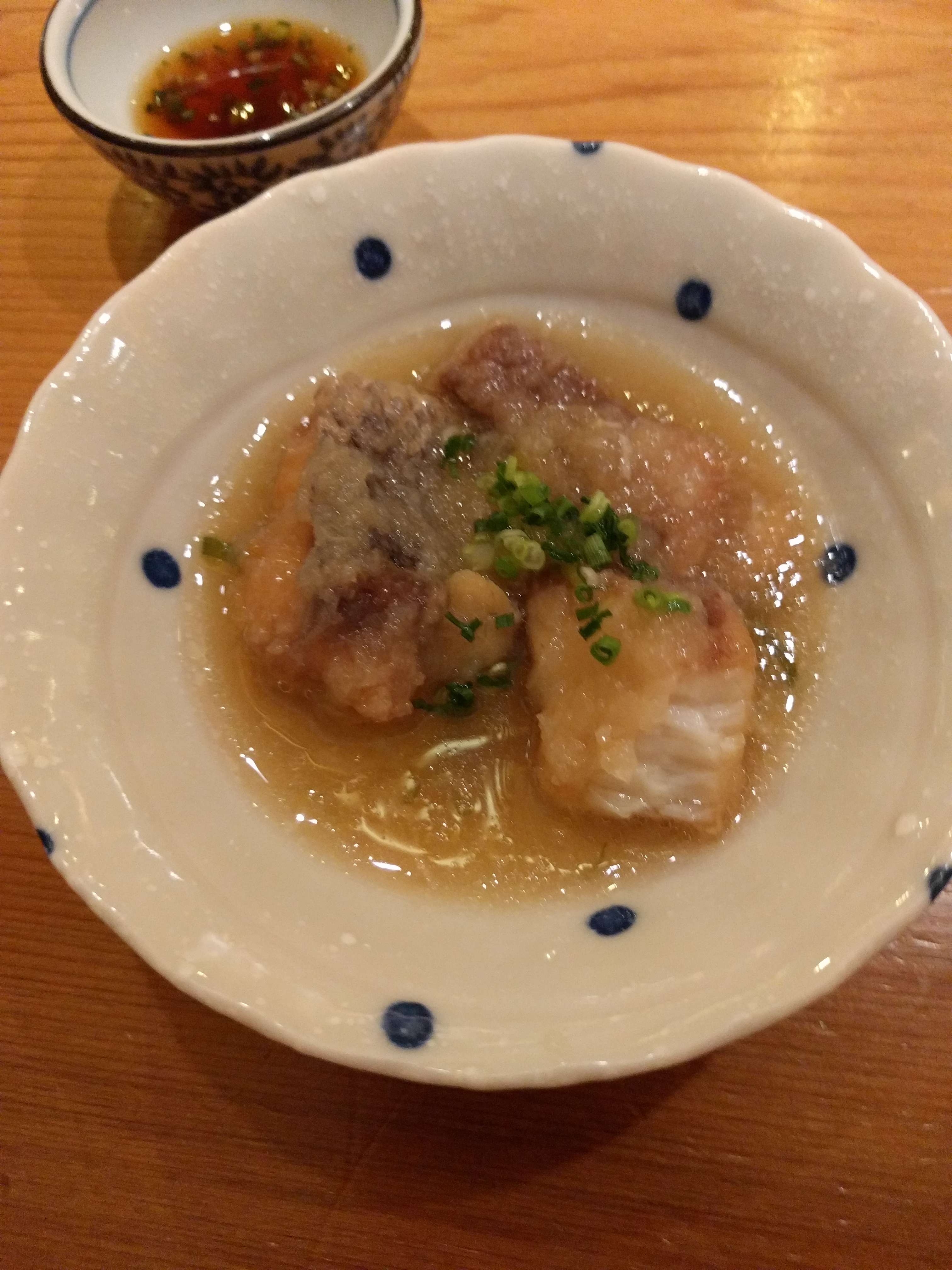
Flaky whitefish in soup, with what tasted a bit like tempura batter. It wasn't mushy but the textures were soft and blended nicely, with a bit of sweetness. More filling than what an amuse-bouche typically is but maybe that makes sense for a sushi meal, where the courses are small, so as to quickly allay diners' initial hunger.
1st course: flounder sashimi with ponzu
Like all the soy sauce, wasabi, and tempura sauce (I feel like "liquid" would be more appropriate than "sauce") the ponzu was light and subtle in both color and taste, so as to not overpower the fish.
The lightness here, combined with the fact that we were eating real wasabi (the helper chef ground it from the root right in front of us), not horseradish or powdered wasabi mixed with horseradish-- contributed to one of the main impressions I had from the meal. This wasn't a regular sushi meal, but with higher quality ingredients and preparations-- instead, the overall taste was qualitatively different. "regular" sushi (everything I'd previously eaten), which I enjoy, has among its signature tastes: the nasal spiciness of the horseradish, plus the saltiness and acidity of the soy sauce, plus the acidity and fermented-ness of the pickled ginger. (I know the ginger is supposed to be a palate cleanser only, but with lower-end sushi I think it just tastes better with the fish.) It's piquant, and great with fishy-tasting fish, plus some rice, so the whole flavor-bomb-mélange isn't overpowering, but that general mix of tastes wasn't part of this meal. Instead, the overall taste was non-fishy fish, wasabi, maybe soy sauce (depending on the course, at the chef's direction), plus vinegared rice for the sushi courses in the second half of the meal. I'm not entirely sure about the set of reasons why the fish tasted less "fishy". Of course it was delicious, but the thing I felt the most at-a-loss to appreciate was the different aspects of the fish itself: precisely how high-quality it was, what made it high-quality, how you could taste that, the cut, the species of the fish, whether or not it was aged, etc. etc.
But as you'd expect, the focus was on bringing out the flavor of the fish. (Though there were also more cooked courses than I expected.)
Later on in the meal, we were served some chunks (not slices) of lightly-pickled ginger and unpickled radish, as a palate cleanser to be eaten between courses. The ginger looked and tasted quite different from the pickled ginger you typically get with sushi. It wasn't stringy-- if anything, a bit spongy-- and had a clean taste without harshness.
The wasabi was awesome and had a lot complex texture, with a deeper and milder taste than horseradish. This was my first time eating pure, real wasabi. When C. and I made sushi at home before, the best we could find at the store was a jar of dried half-wasabi-half-horseradish powder that you had to rehydrate into a paste. It was expensive and not that tasty.
2nd course: sashimi, unknown seafood
Didn't take a photo, didn't understand what the chef said. Two pieces served on top of a full, circular slice of lemon, recommened to eat with wasabi. Taste and texture like some kind of seafood, not fish (but I could be wrong), a bit springy, but not chewy or tough like squid can be. Definitely not a crusteacean, but could be a specific cut of octopus or squid. White in color, with a strip of brown. A nice textural contrast to the first course, with a clean, light seafood flavor, and a hint of citrus from the lemon.
3rd course: yellowtail sashimi
Two pieces, recommended to eat with wasabi and soy sauce. Honestly, I'm not sure how to describe it. Disregarding the wasabi, soy sauce, and natural fish flavor of the yellowtail, there was something else subtle there that I can't put my finger on. I want to say there was a faint hint of sourness in addition to something else? Looking back, this was my favorite course, which is pretty typical for me-- I have a tendency to enjoy light, complex or unique flavors encountered near the beginning of the meal.
4th course:


Again, not sure what this was. Recommended to eat with wasabi. The strips on top had a smoky taste, which made for a great texture/flavor contrast. At this point, I still had the deer-in-headlights feeling, and was mentally pinching myself, so I can't say I remember everything clearly, but this was one of my favorite courses.
5th course: conpoy, or dried scallop ("干貝")
Prepared in front of us with lemon juice and lemon zest, then served warm in a sheet of nori. When adding the lemon zest, the chef would zest a lemon onto the grater, then hold the grater over the scallop while using a brush to gently brush the zest onto the top of the scallop. Can't think of a non-hyperbolic way to say this, but it was extremely good, especially because of the warmth (temperature contrast with the sashimi courses) and lemon flavor from the juice and zest. I got a bit behind at this point because I was savoring the scallop, and didn't finish it until the next course was already waiting in front of us.
6th course:
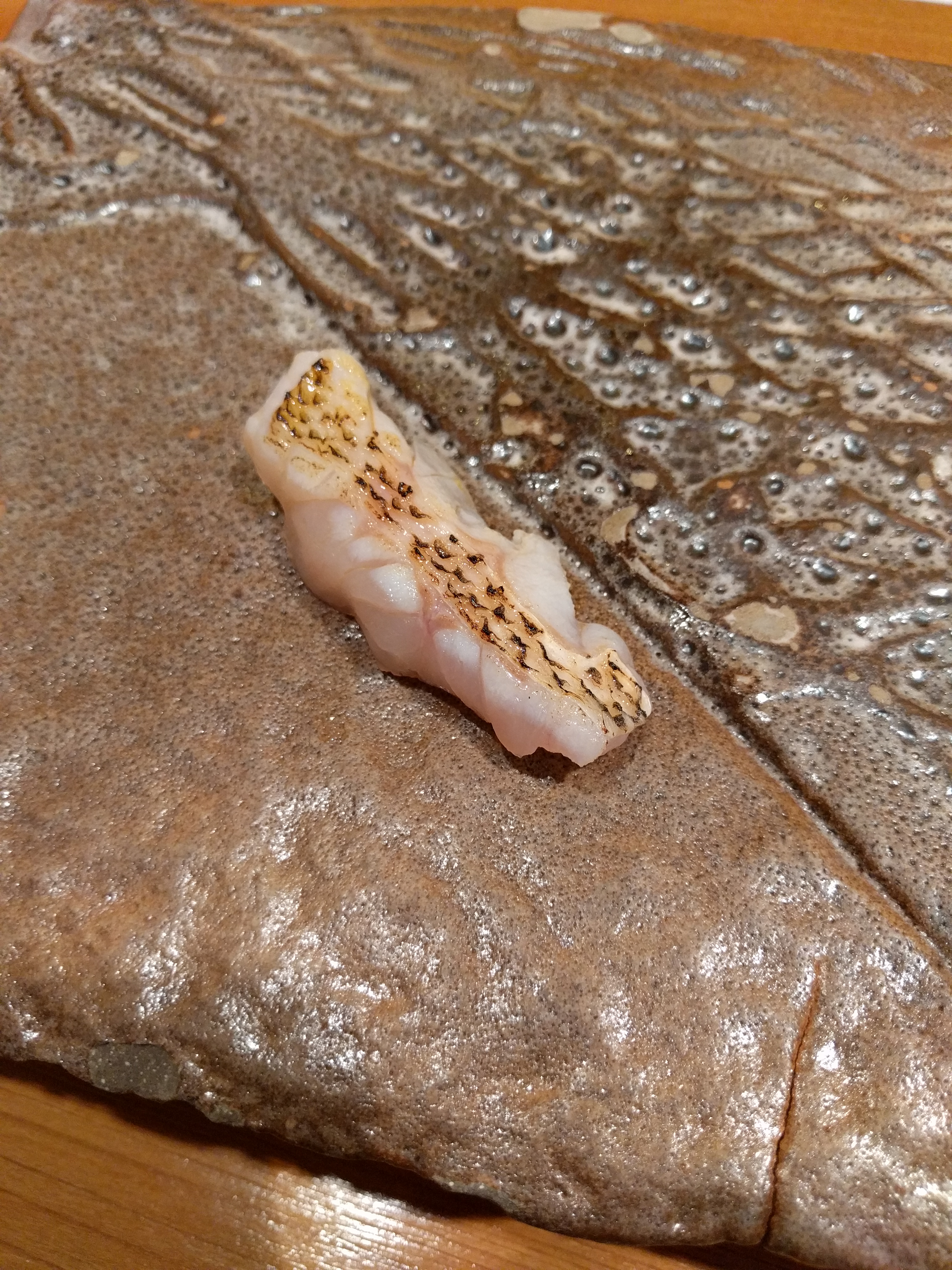
Not sure what this was. (Update: a friend says "#6 might be beltfish (tachiuo), given the patterning on the torched skin, but it looks a bit different from most beltfish that I've had so I can't swear to it.")
7th course:
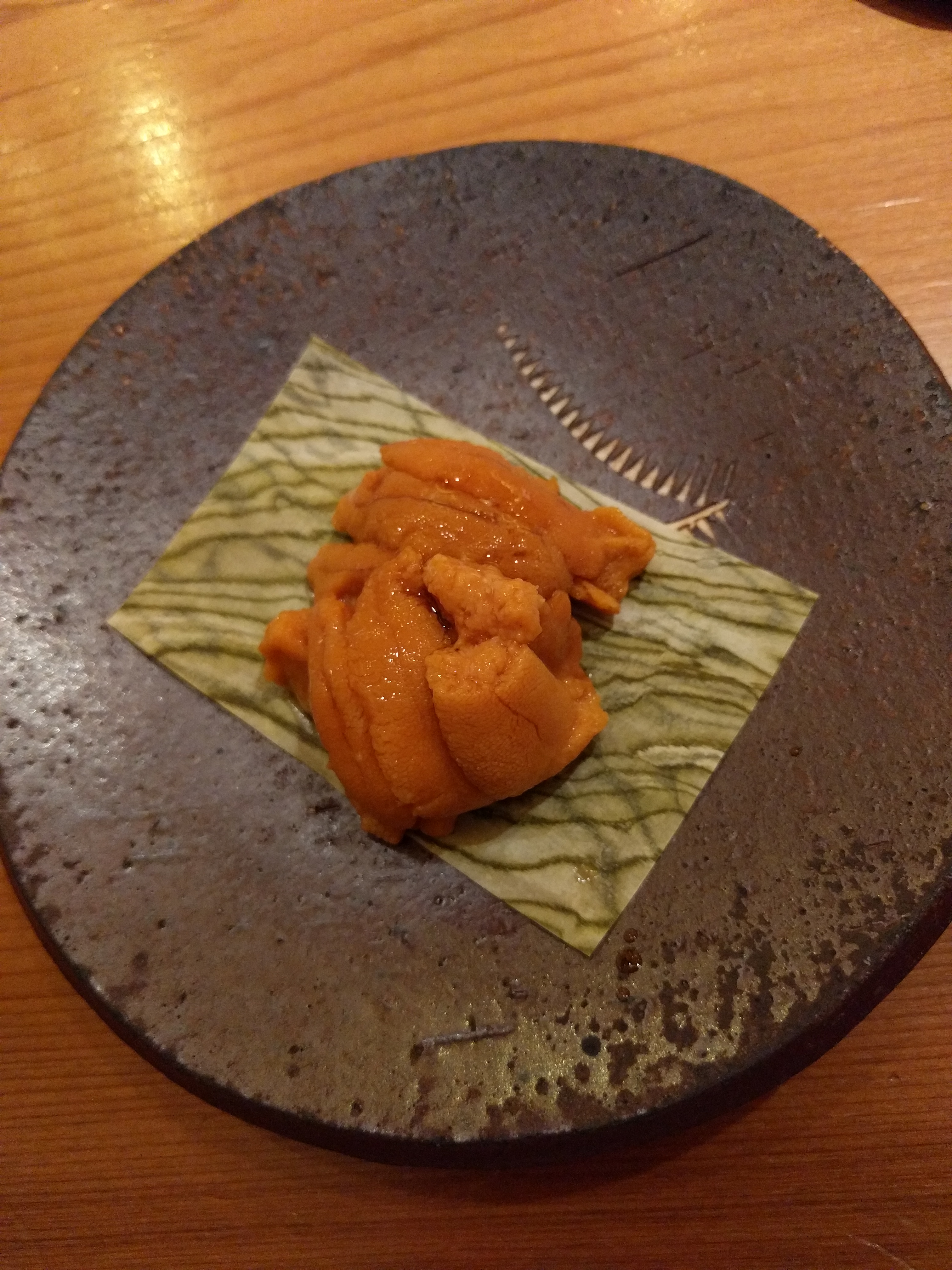
uni with-- if I heard the chef correctly-- kombu, but the seaweed here wasn't like any kombu I've encountered, so this was probably a different variety, or I just misheard him and it's a totally different kind of seaweed. He instructed us to wrap the kombu around the uni and pick it up with our fingers. This was a lot of uni, and the flavor was just as rich and intense as the color suggests. I ate it in two bites, but I wanted to stretch it out over many more. I have a tough time with the 'eat each piece in one bite' custom, especially when there's so much to savor. Since uni is an expensive ingredient with a strong taste, I was surprised to encounter it at this stage in the meal; not sure to what degree that's customary. Incidentally, this was our last sashimi course.
8th course:
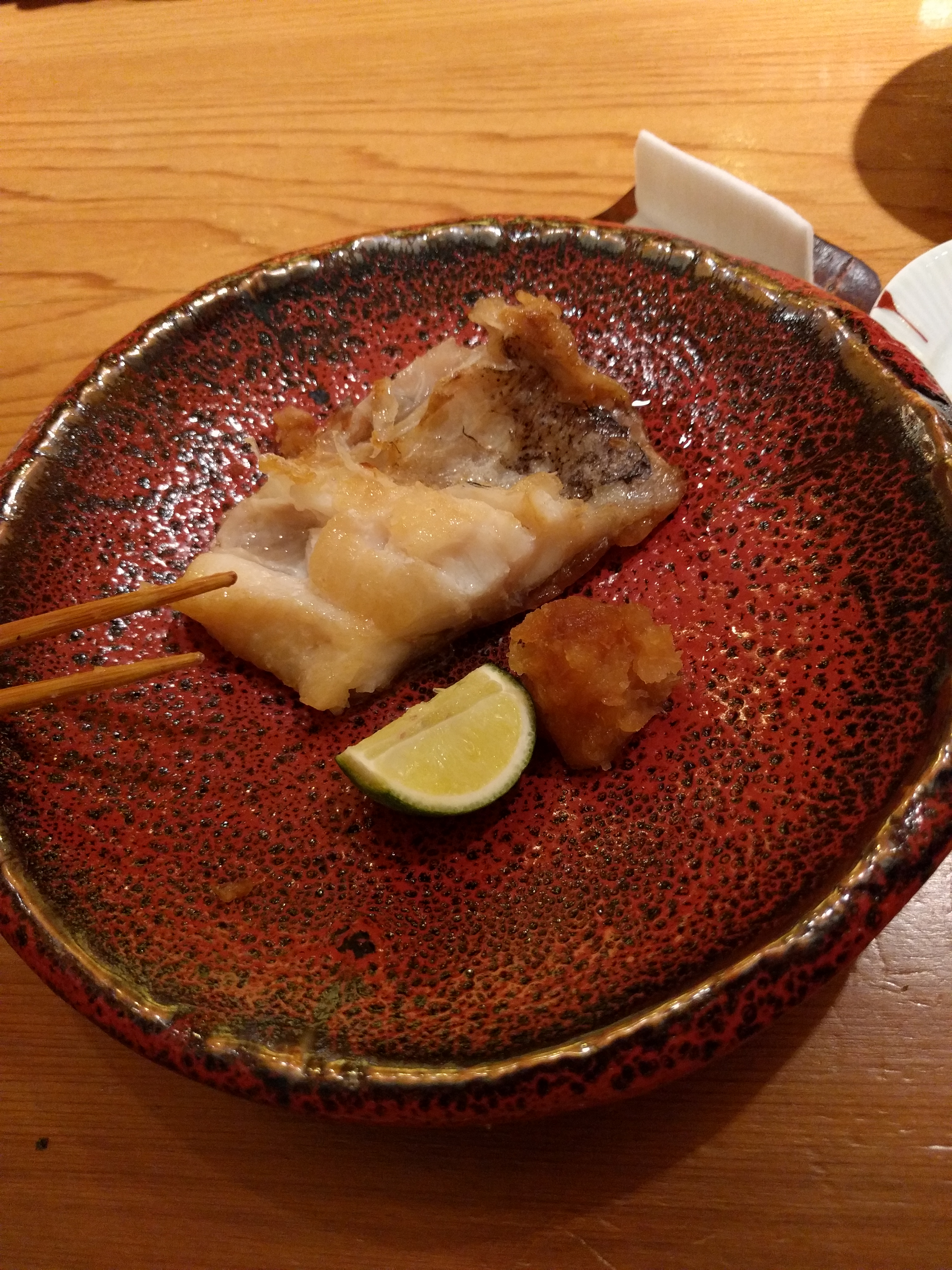
(the underside of the meat, after I'd started eating it)
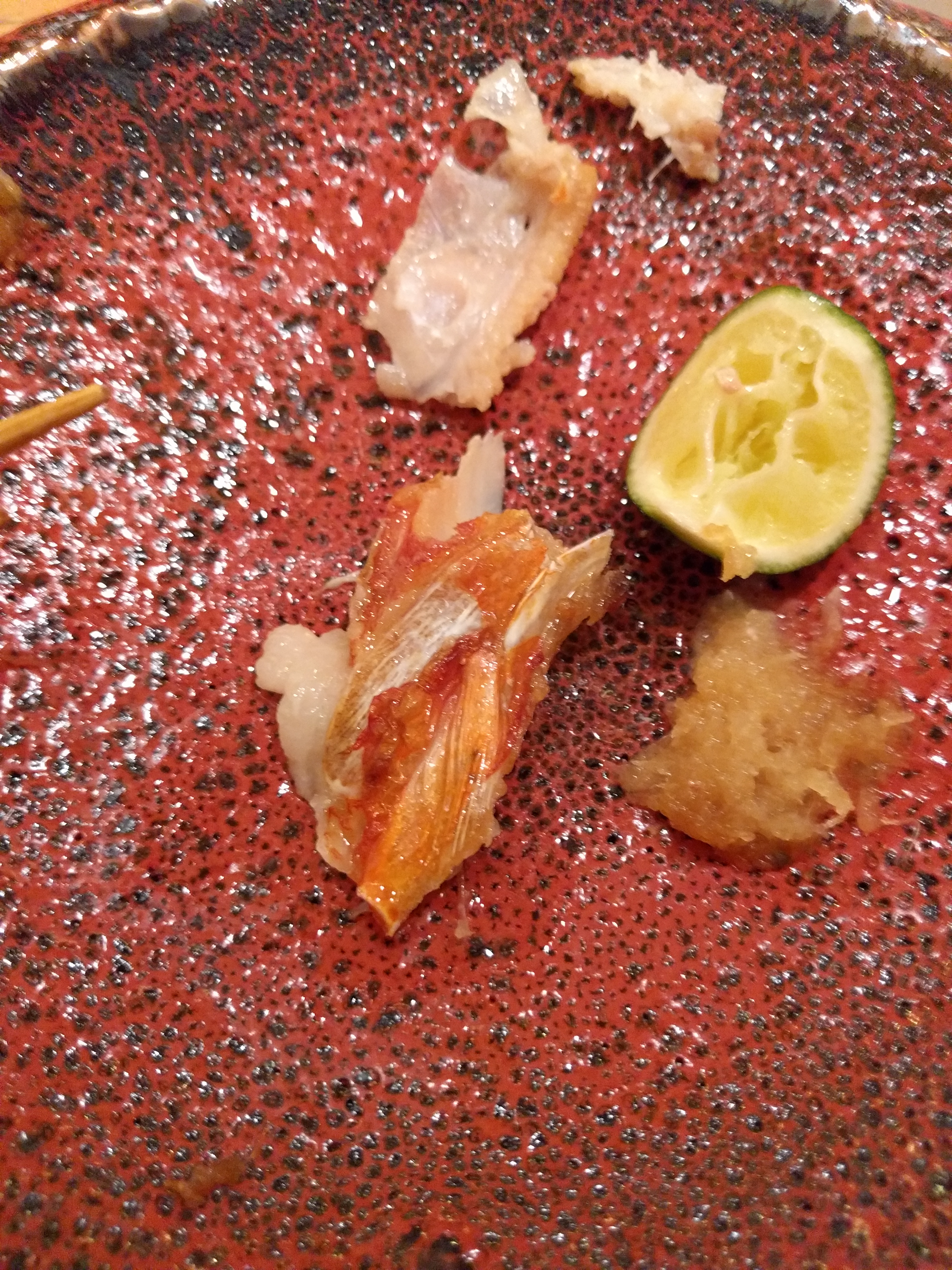
(a shot of the skin, almost finished)
My photos here really don't do the food justice. Roasted (?) fish with lime and garnish (wish I knew what the garnish was). Red skin, white flesh, could have been some kind of cod, but the texture was a bit different than the cod I've had and there was more delicious liquified fat. The red color of the roasted skin was striking.
9th course: kinmedai nigiri (“金目鯛”)
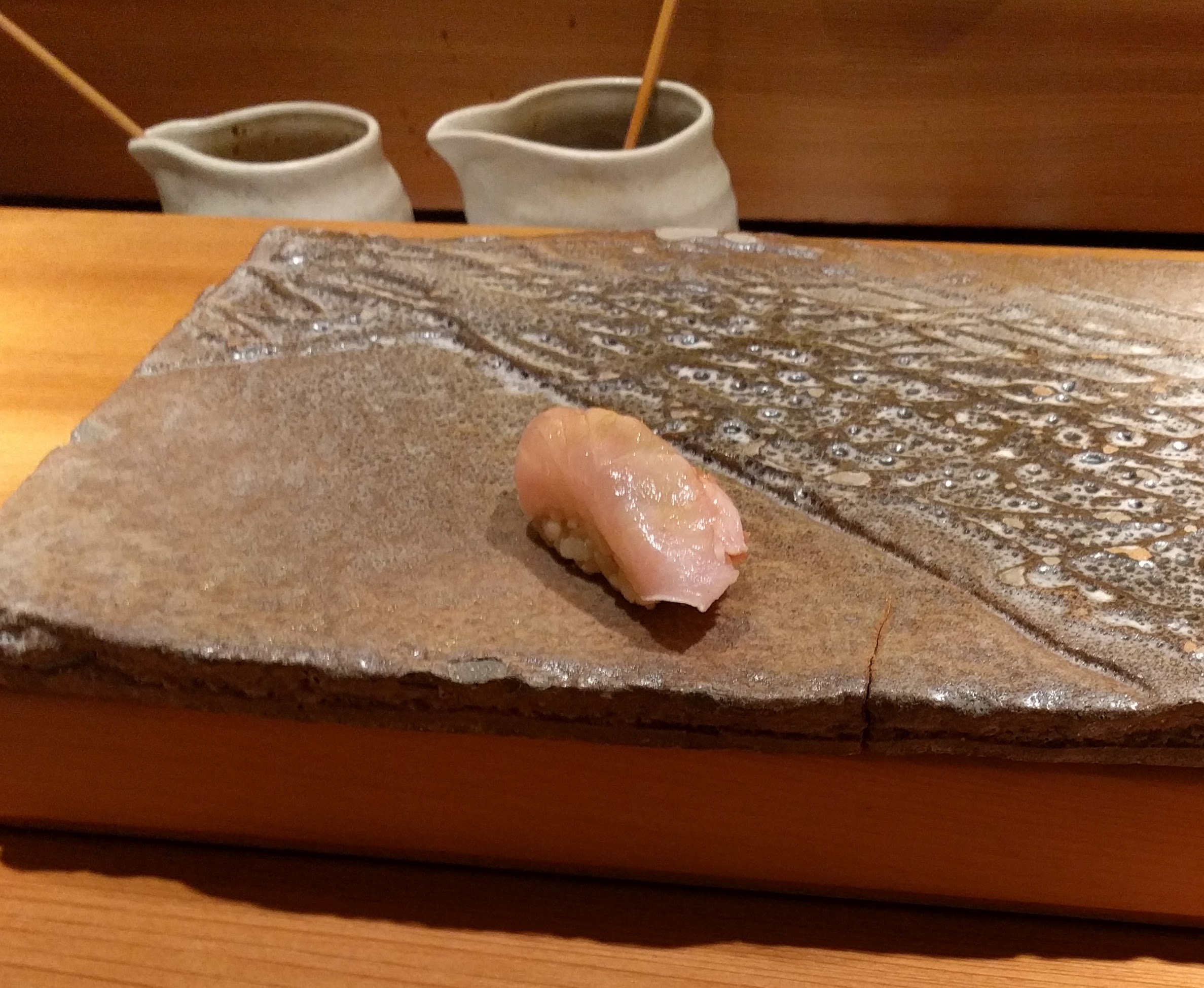
In my notes I wrote "extremely delicious" but I don't remember the specifics of the taste. This was our first nigiri course, with wasabi between the fish and the rice. Our chef varied the amount of wasabi with each course, increasing it somewhat closer to the end, and as the flavors got stronger. For some courses, he would also brush the top of the fish with soy sauce. At least to me, the rice tasted lightly vinegared; the vinegar was noticeable, but not too strong, and I wouldn't have added more. The rice was quite soft. Though it helped me get full, my general impression was that I enjoyed the sashimi courses a bit more, since it was slightly easier to hone in on the taste of the fish. On the other hand, with the nigiri courses the wasabi was nicely distributed over the length of the fish, so the flavor was more cohesive.
10th course: ika nigiri (squid)
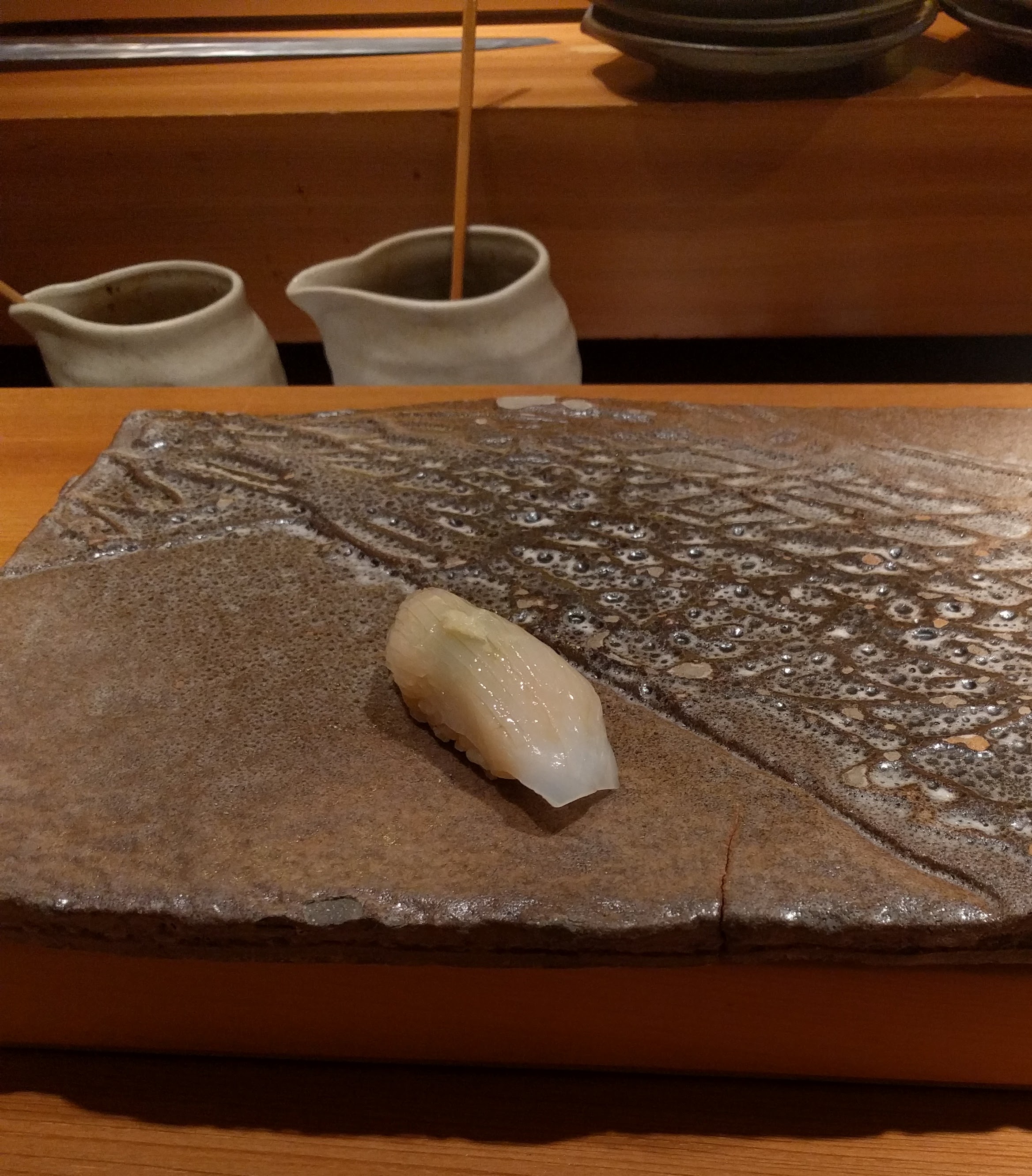
I really enjoyed the development of the texture here, but this was one of the less impressive courses because the flavor wasn't as noticeable, and it still seemed a bit too chewy at the end. Not sure to what degree that's inherent for squid, or if I just haven't learned to appreciate it yet.
11th course: shima-aji nigiri (striped jack)
Delicious. Unfortunately I don't recall the specifics, but The Sushi Geek has some interesting notes on shima-aji.
12th course: shrimp nigiri
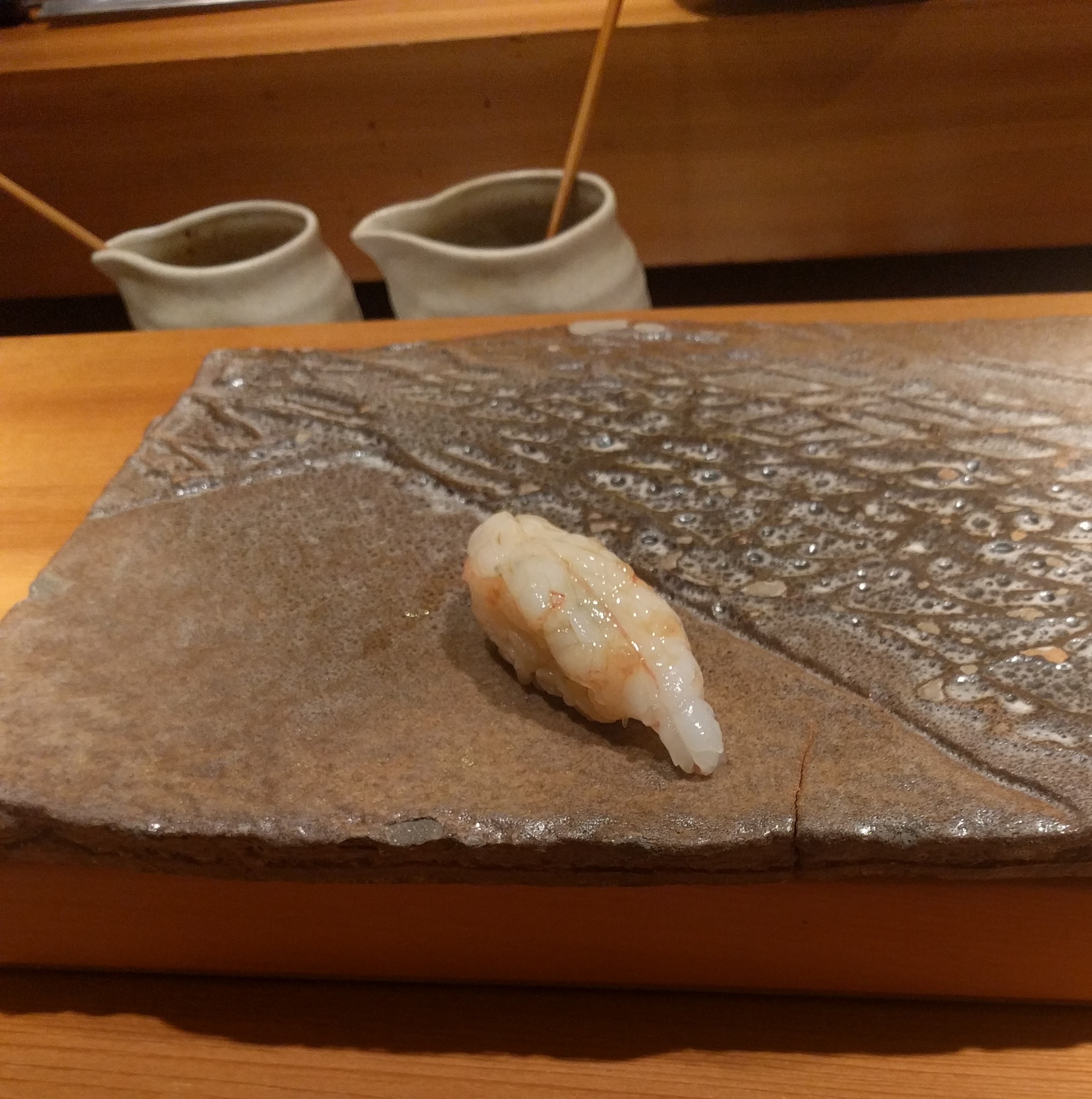
Not sure precisely what kind of shrimp this was. Soft and delicate with a very strong and clean shrimp flavor; melted in my mouth, definitely special, but on the whole a bit rich for my palate.
13th course: ishidai nigiri (striped beakfish)
This one took a lot of Googling. I got the name from the chef in both Chinese and Japanese, but got the phonetics wrong for the Japanese. The Chinese wasn't easily search-able, so I ended up tracking it down via a list (in Chinese) of different kinds of porgies (also known as both sparidae and sea breams!).
14th course: yellowtail stomach nigiri ("yellowtail的肚子”)
The chef pointed out that this was richer than the yellowtail we had earlier; just as he said, there was a delicious clean fat taste. To me, there was a bit less of the fishy complexity, and I think I would have enjoyed this course more earlier in the meal.
15th course: marinated maguro nigiri
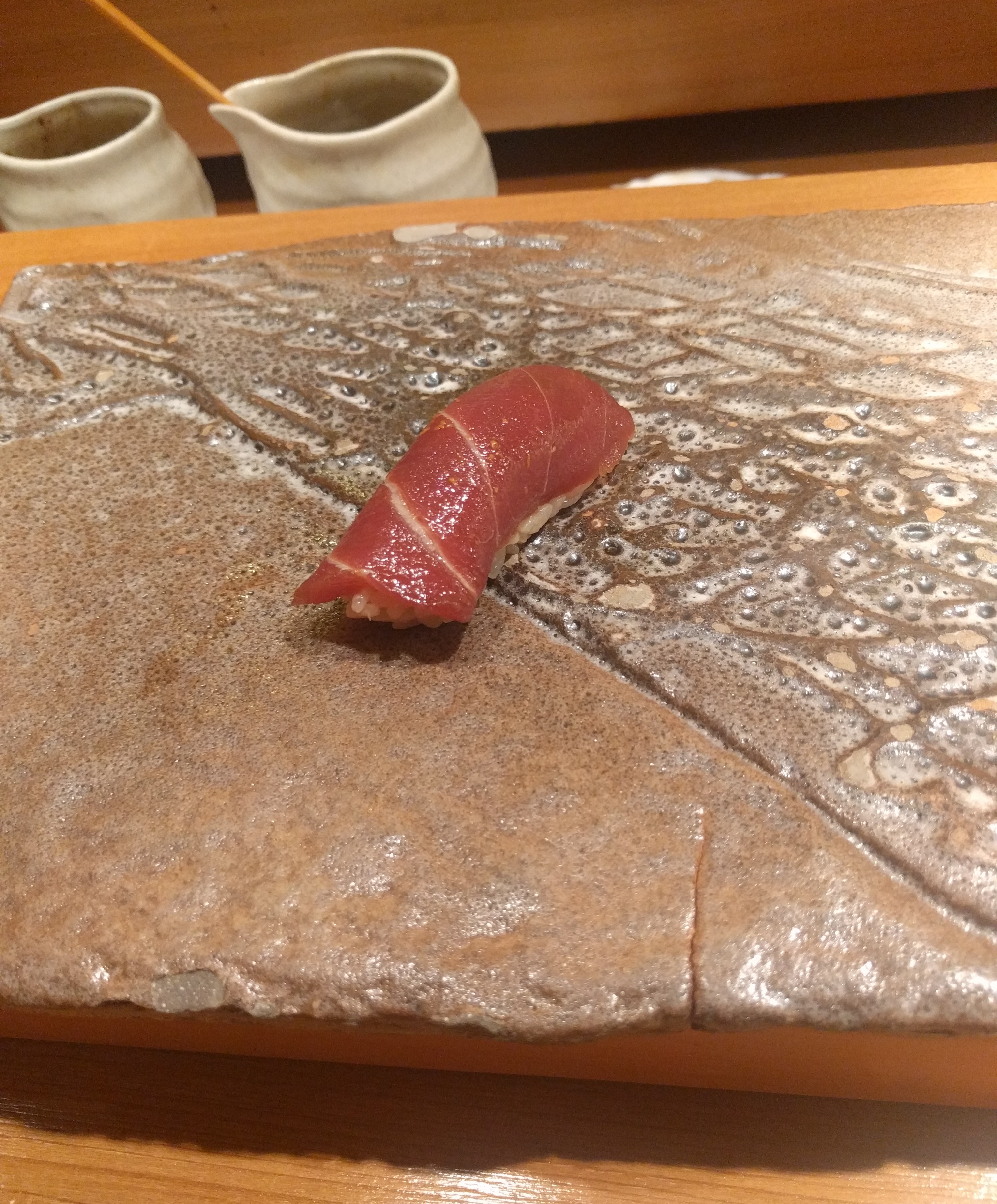
If I understood the chef correctly, this piece was pre-marinated in soy sauce, which is how it tasted, but there was something else there too-- maybe shisho in the marinade? It was pretty awesome, definitely one of my favorite courses, and not as salty as you'd expect.
16th course: chutoro nigiri
Delicious tuna. What more is there to say?
17th course:
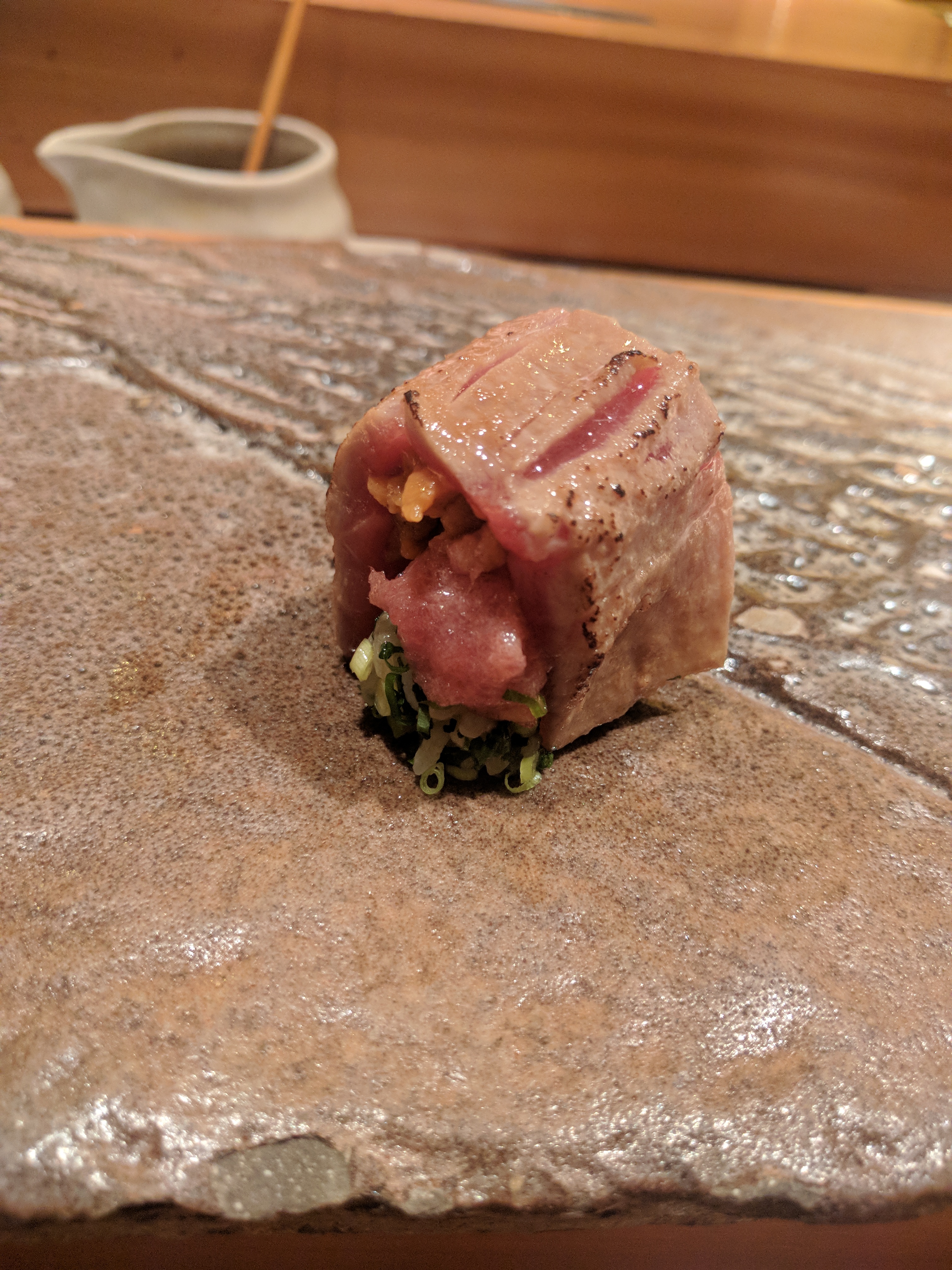
Cooked tuna draped over uni, on top of-- if I heard correctly-- negitoro, or fatty tuna + green onion. It truly tasted as decadent as it looks, and at the chef's jovial insistence, we did our best to eat it in one bite!
18th course: eel tempura
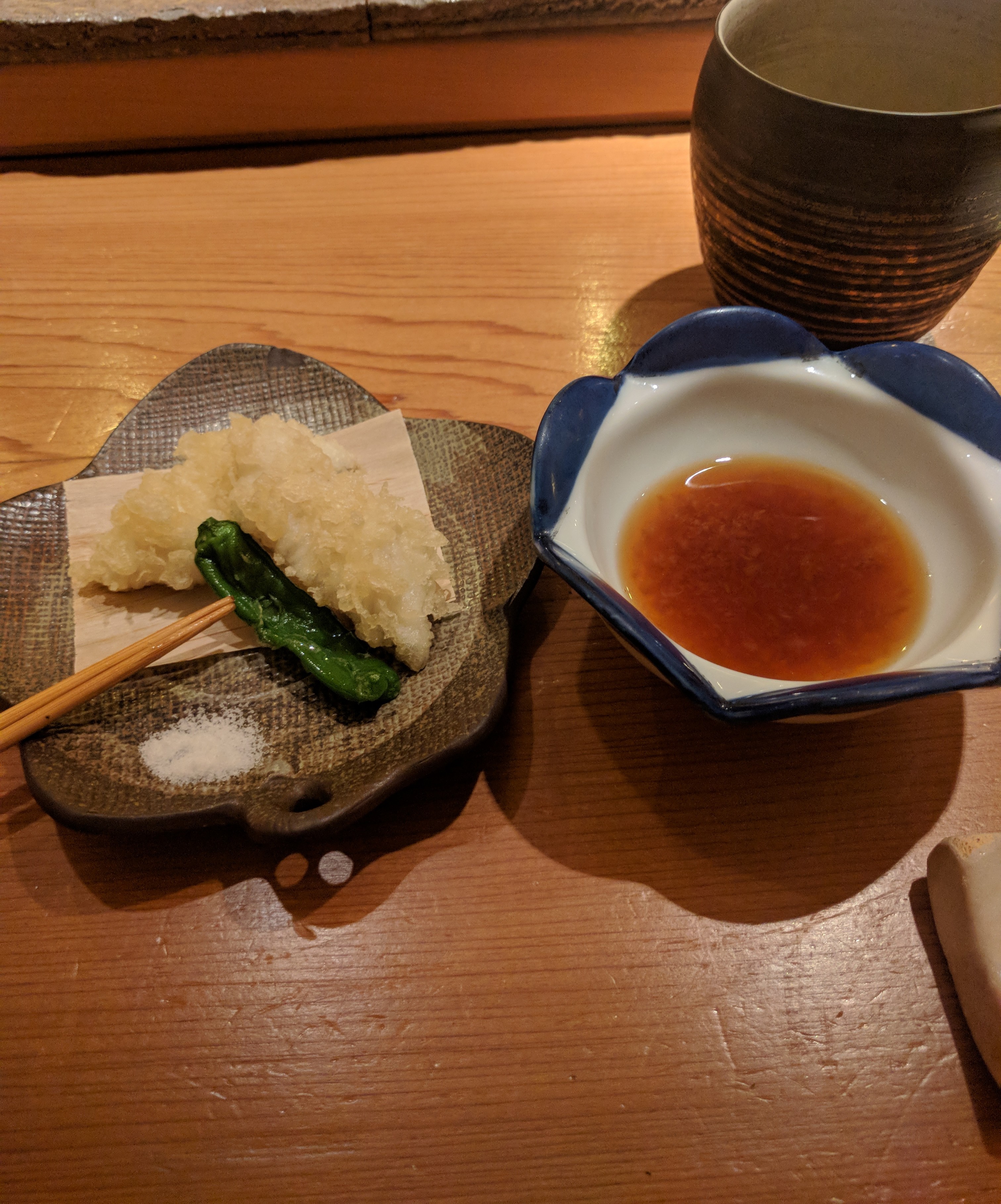
As far as I remember, I haven't eat white eel before. The tempura was amazingly light, not oily, and balanced perfectly with the sauce (also light), pepper, and salt. Of course the eel was delicious, and it tasted more like oily whitefish than regular unagi (which I also love).
19th course:
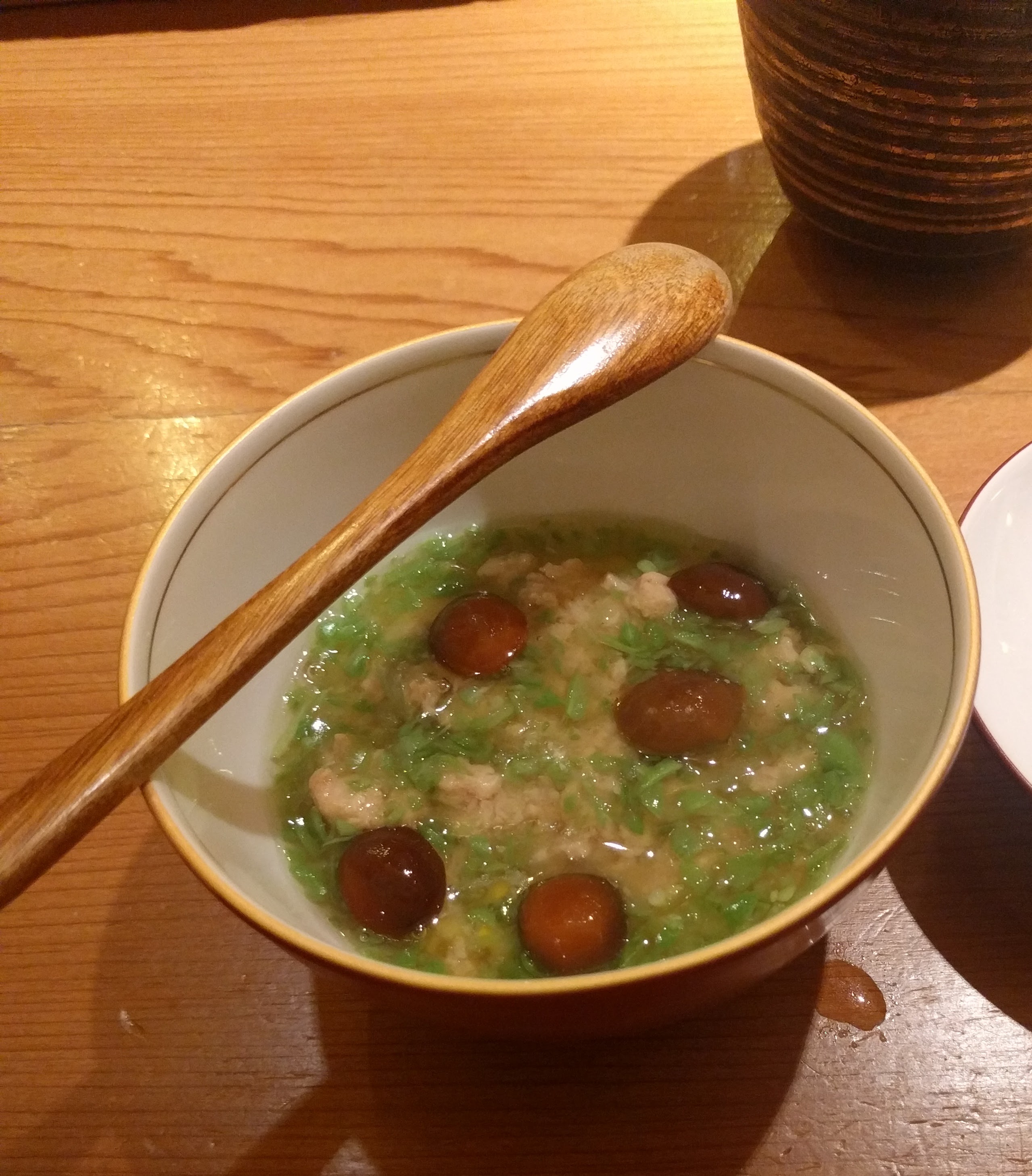
This was the most unexpected course, and I'm not sure how to describe it. It was sort of a soup, sort of a savory pudding, with broth, muchrooms, and green onions on the top, and a layer of starch on the bottom. The starch might've been baby corn purée, potentially mixed with potato? It had a bit of the sweetness of corn, but the flavor was more delicate. The mushrooms were so tender, with the right intensity, neither bland nor overpowering.
I might be going out on a limb by saying this, but this course struck me personally as very Taiwanese, with flavor that seemed to reflect a Chinese influence, plus the melding of three different soft textures in the mushrooms, broth, and starch.
20th and 21st courses: tamago, mussel soup with shisho
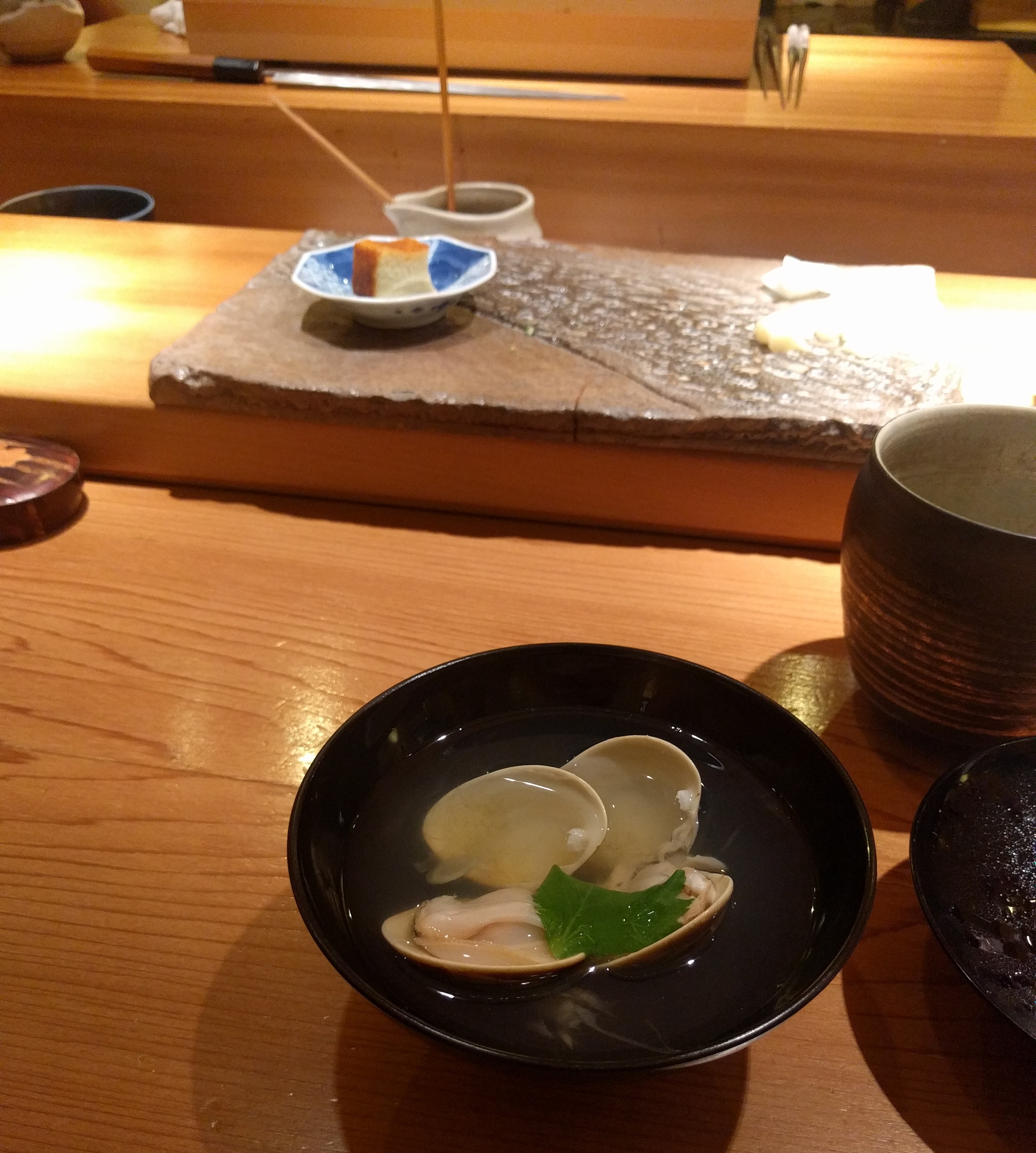
The chef said something about the tamago I didn't quite catch. Both of these were delicious articulations of the essential taste of the dish. The tamago wasn't too sweet and I definitely would've eaten more if I could have. The soup broth was amazingly clear and pure in taste. I've had that soup before, but after eating Kitcho's version I might be a bit spoiled.
22nd course: fruit, hot tea
A simple and satisfying end to the meal. I'd been drinking tea all along but this was a small cup of what seemed to be a different kind of tea. Unfortunately it was too hot for me, so I wasn't really able to drink it. There were three pieces of fruit, one of papaya, one of honeydew (I think?), and one of something else I didn't recognize. The papaya was served with a single tiny leaf on top as garnish, which I also didn't recognize.
Fin.
This was a wonderful meal and I feel very lucky that we were able to enjoy it. One of the strongest impressions it left was the overall delicacy and subtlety of the flavors, which is unfortunately unusual for high-end dining in the USA. On a scale from 1 to 10, where 10 is the most intense thing I've tasted, I'd say that the most intense course, the uni sashimi, would be a 6, while most of the courses would fall between 3 and 4. Which for me is a great thing! Creating delicious cuisine without strong flavors is difficult, powerful when it succeeds, and in my opinion, all-too-rare in the culinary world.